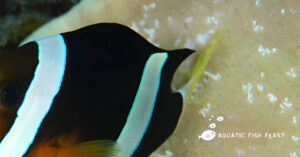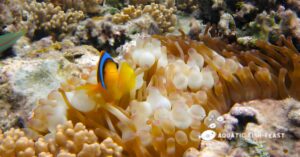Which anemones host clownfish? My findings show that ocellaris clownfish will naturally host Magnificent Sea Anemones (Heteractis magnifica), Giant Carpet Sea Anemones (Stichodactyla gigantean), and Merten’s Carpet Sea Anemones.
Anemones are not necessary for clownfish survival or growth. However, they usually accept them.
As you read on, I’ll tell you which anemones house clownfish and more.
Now, let’s get started.
Table of Contents
What Is The Relationship Between Anemones And Clownfish
In nature, clownfish and anemones are interdependent.
So clownfish depend on each other because anemones feed them, and they defend themselves from predators.
Clownfish of different kinds typically favor cohabiting or hosting anemones of different kinds.
It makes sense to attempt one of these natural pairings if you’re building up an aquarium and want to maintain clownfish and anemones, but don’t be shocked if your clownfish have other ideas.
Nothing is set in stone regarding marine life; many clownfish will not approach their “preferred” anemone.
Clownfish, which have rejected every anemone they have seen, have been shown to host a variety of organisms besides anemones, such as feather dusters and toadstool corals.
After a few generations, some aquarists think clownfish bred in tanks do not host anemones as frequently as clownfish collected in the wild.
One theory is that because their parents and grandparents were never exposed to anemones, they never developed the impulse or need to protect themselves from possible predators.
What If Your Clownfish Doesn’t Like Its Host With Anemones
Clownfish may survive without a host and appear to have highly particular preferences.
However, most clownfish raised in aquariums will host practically everything; some even venture to the corners of tanks, powerheads, and tank filters.
They act in whichever way they choose. Therefore, it is impossible to say which clownfish will host which coral or anemone.
The recommendations I’ve provided are derived from the most typical experiences of many clownfish owners and, of course, from how they behave in their native habitats, such as the sea floor.
There’s no need to panic if your clownfish acts strangely and doesn’t get along with their new home. This is rather typical of clownfish kept in captivity.
In this situation, there isn’t anything you can do because corals and anemones aren’t even required.
Thus, you may leave them there, and your clownfish will find another host if they don’t like their new home.
Alternatively, you may present an alternative type of host and gauge their level of approval.
However, the host may occasionally cease growing even when the clownfish still like them, as with torch corals. In these circumstances, corals may also perish.
The procedure is trial and error because every clownfish is unique and behaves differently.
Therefore, the best action is to try several approaches and see which suits you best.
What Is The Best Anemone For Clownfish
Only 10 of the approximately 1,000 species of anemones are known to serve as hosts for clownfish.
Only those 10 anemone species are home to clownfish from the Premnas and Amphiprion genera. The symbiotic anemones are not closely related to the clownfish, though.
The clownfish anemones are classified into three families:
1. Family Actiniidae
The beach and temperate water species of sea anemones belong to the biggest and most well-known family, Actiniidae.
Nevertheless, none of the anemones in this family host clownfish because many are situated in areas with colder water.
2. Entacmaea quadricolor, or Bubble Tip Anemone
Bubble Tip anemones dominate home marine and reef aquariums.
Red and Black, Red Saddleback, Clark’s Yellow Tail, and Cinnamon Clownfish admire these sea anemones.
Compared to Carpet anemones, these are less predatory and easier to reproduce.
3. Heteractis crispa, or Sebae anemone
Known by most as the Leathery sea anemone, Heteractis crispa is usually yellow, beige, or various hues of green in color.
The term “anemone” comes from the leathery look of its tentacles, which can also have bright purple, blue, or mauve tips.
Leathery anemones host about fourteen distinct species of clownfish, including Saddleback, Tomato, Pink Skunk, and Fire Clownfish.
This kind of anemone is among the most often imported types; however, experienced hobbyists are advised to keep them as they don’t always thrive in captivity.
Do All Clownfish Host To Anemones
According to my previous remarks, anemones and clownfish depend on each other to survive. Anemones are clownfish’s main defense against predators.
Clownfish are impervious to anemones’ stinging tentacles, which protect them. Anemones’ food source is clownfish.
Occasionally, the clownfish may swim into the anemone or drop food upon it, stinging the predator and turning it into a fish meal for the anemone.
Clownfish are not always friendly toward anemones; some have been found to harbor excessive non-anemone-related organisms, such as feather dusters and toadstool corals.
The most common pairs are clownfish of the Ocellaris or Clarkii species paired with Bubble-tip anemones.
Other names for the Bubble Tip Include the Rose Bubble Tip and Bulb Tentacle Anemone. They are available in a wide range of hues, from plenty of yellow to green to dark red and purple.
Others have made numerous suggestions on how to encourage them to couple up. The most popular one involves inserting a photo of a different clownfish host into the anemone.
Before attempting any solutions that other people have done, make sure you conduct some research. The last thing you want to do is stress out your fish or anemone.
Can All Species Of Anemone Host Clownfish
Choosing the incorrect kind of anemone is the main error made by novices who are attempting to adapt clownfish to anemones.
It is quite alluring to get the brightest anemone for your clownfish. It should function if it looks fantastic in the tank.
False. Only some anemone species are capable of supporting clownfish. First, know what kinds of anemones normally form bonds with clownfish.
The most common hosts are carpet anemones, bubble-tip anemones, Sebae anemones, and superb anemones.
Before you begin this process, a clownfish will naturally couple with any of these four varieties of anemones.
The bubble-tip anemone hosts the majority of these four clownfish species. Because of its reputation for easy maintenance, the bubble-tip anemone, or BTA, is a great choice for novices.
You will find that tank-propagated BTA is easily accessible, which facilitates your acclimatization process.
Compared to other kinds of anemones that are suitable for clownfish, BTA might occasionally be more affordable.
Therefore, we strongly advise utilizing BTA as a host if you don’t have much time to care for your clownfish.
How To Acclimate Clownfish To Anemones
Now that you know the anemone kinds that clownfish may safely be coupled with, let’s move on to the main topic of this post.
Now is the time to instruct you on acclimating clownfish to anemones:
1. Take His Home Area Away
Your clownfish has what he views as his home zone, as you will see if you observe it closely. This is particularly true if your clownfish has been contentedly residing in the tank for a considerable time.
If this is the case, your clownfish could disregard the anemone you recently put in your tank. There’s no need to swim to the anemone for safety, as they are already at ease within the tank.
You must remove the item your clownfish views as his home area to get him used to this situation.
Since clownfish enjoy starting new colonies, they must find a new one when their current host dies.
You may restore the previous aquarium’s layout after clownfish have happily adapted to their anemone.
As an alternative, you may choose to reorganize your tank’s underwater scenery. The clownfish will attempt to build a new home territory with the anemone in this seemingly unfamiliar habitat.
2. Include Larger Fish
Putting larger fish in your aquarium is another simple method to help clownfish get used to anemones.
We do not mean to introduce predatory fish into the aquarium when we say “bigger fish.” We recommend adding fish that are bigger than the clownfish instead.
The clownfish will feel the urge to defend itself against these foreign organisms if this is done.
Clownfish will naturally go towards anemones as they offer them natural safety in the environment, and they will even swim there to build their home.
And with that, a lovely symbiotic connection begins. We advise adding fish that can coexist peacefully and securely with your clownfish.
I recommend yellow tangs, reef-safe angelfish, or larger reef-safe butterflyfish than your clownfish if you have a reef.
3. Shift to a More Compact Tank
Moving the clownfish temporarily into a smaller tank is another way to help them get used to their new home—an anemone.
Only the anemone and the clownfish should be in the smaller tank, ensuring the latter has nowhere else to go.
Ensure the aquarium is still large enough to submerge the anemone completely before proceeding.
Additionally, confirm that your clownfish won’t feel overly constrained by it. Use your standard clownfish tank and add enough water to immerse the anemone.
In this manner, the clownfish will have less water to swim on and may quickly mate with the anemone. However, we must advise you against adopting this strategy.
Keeping your clownfish in an inadequate tank might cause great stress. Thus, only do this if the other two approaches are ineffective.
Final Thought
Now that we have established Which anemones host clownfish, I hope you take excellent care of both species now that you know how to adapt clownfish to anemones.
Thanks to their symbiotic bond, they will be able to exist, but you must also contribute to keeping the tank habitable for them both.
If you follow the advice we’ve covered above, your clownfish will host in the anemone without any issues.
You have to be patient and ensure the clownfish doesn’t become overly anxious during the host switch, even if it takes some time.
Other Articles:
- Can Clownfish Eat Bloodworms
- Can Clownfish Live In Freshwater
- Can Clownfish And Goldfish Live Together
- Can Clownfish And Seahorses Live Together
- Can Clownfish Reproduce Asexually
- How Many Clownfish Should Be Kept Together
- How Many Clownfish Species Are There
- Why Do Clownfish Have Stripes
- Can Clownfish Change From Female To Male
- Can Clownfish Live With Seahorses
- Can Clownfish Live Alone




